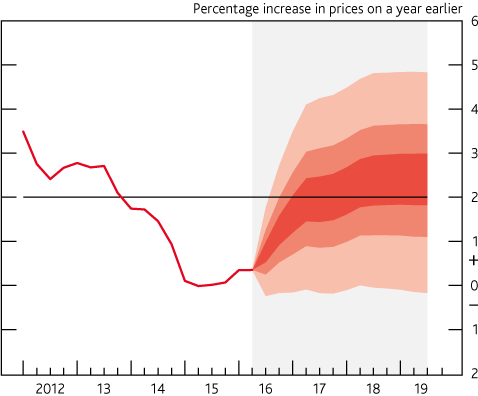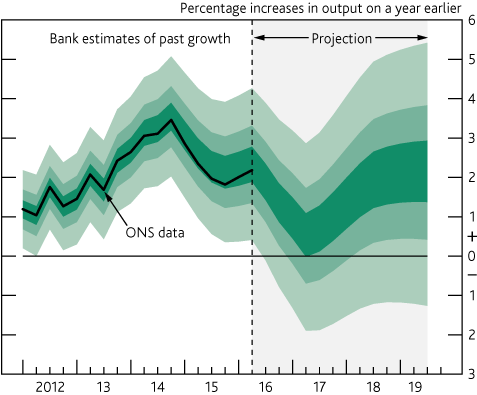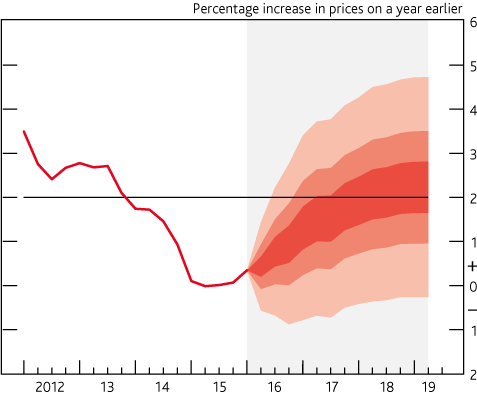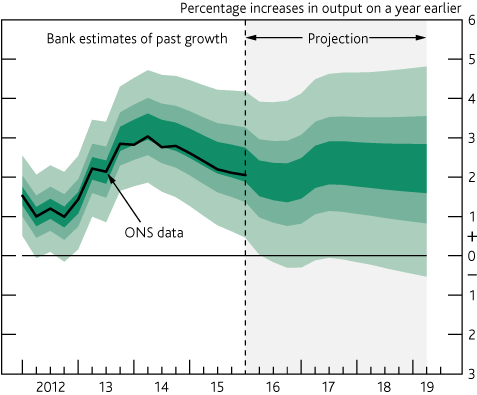Financial markets and global economic developments
Following the referendum on UK membership of the European Union, sterling depreciated sharply and the prices of domestically focused risky assets have fallen. The referendum also appears to have contributed to falls in the prices of risky assets in some other economies, particularly the euro area. Elevated uncertainty and a weaker growth outlook in the United Kingdom are projected to weigh a little on the outlook for global growth in the near term.
Read more on financial markets and global economic developments
Demand and output
The vote to leave the European Union is likely to affect GDP growth through a number of channels, but there are currently few post-referendum data available to assess the scale of those effects. Growth was firmer than expected ahead of the referendum, but the available indicators suggest that domestic demand growth is likely to slow over the near term as greater uncertainty and lower confidence drag on activity. That is already apparent in the housing and commercial property sectors, where indicators point to significant falls in activity. The large depreciation in sterling should, however, support net trade in the near term.
Read more on demand and output
Supply and the labour market
Reflecting the weaker near-term outlook for output, capacity pressures are likely to soften in the second half of 2016. Surveys of recruitment intentions suggest that prospects for labour demand growth have eased. In part reflecting that, average hours worked are projected to fall and unemployment to pick up, leading to a widening in the degree of slack in the economy. The extent to which output recovers further ahead will depend partly on developments in supply, which will be sensitive to the eventual trading arrangements between the United Kingdom and its economic partners. In the near term, the outlook for supply growth is weaker than in May.
Read more on supply and the labour market
Costs and prices
The rise in uncertainty and financial market moves associated with the vote in June to leave the European Union are likely to have contrasting implications for external and domestic cost pressures. The fall in the sterling ERI is projected to push up imported costs significantly. In contrast, the outlook for domestic cost growth is a little weaker, as a projected widening in the margin of spare capacity weighs on wage growth and companies’ pricing decisions. Overall, the near-term inflation outlook is higher than in the May Report.
Prospects for inflation
The vote to leave the European Union is likely to have significant implications for the UK economic outlook. It will take some time for those implications to become clear and the projections in this Report assume that uncertainty around the United Kingdom’s future trading arrangements weighs on the outlook for both demand and supply. There are already signs of a weaker outlook: some uncertainty indicators have risen further; property markets appear to be weakening; and survey indicators of activity have fallen. The sterling exchange rate has also fallen sharply. That will, by itself, provide support to exporters, but it will also raise import prices, weighing on households’ real incomes and pushing up inflation. Overall, growth is projected to slow markedly in coming quarters, opening up a margin of spare capacity. The transition to new trading arrangements with the European Union, and companies’ uncertainty about the impact of those, could weigh on productivity growth in coming years. Supply growth is judged likely to remain below past averages throughout the forecast period. That means a pickup in GDP growth to modest rates in the second half of the forecast period begins to close the margin of slack. There are counterbalancing forces on inflation throughout the forecast period, with a boost from higher import prices and a drag from the larger margin of spare capacity. The exchange rate effect will, however, fade over time. In light of the outlook for activity and inflation, the MPC has announced a package of policy stimulus measures to support the UK economy.




